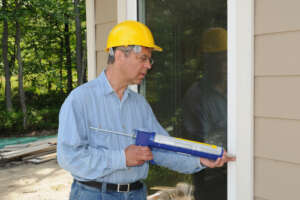Is Your Home Leaking Cool Air? Sealing and Insulating Could Be the Cure
 Sealing and insulating your home keeps coolness and warmth where you want it, when you need it. Air currents and heat energy are always on the move. Where they go, your energy dollars follow. On a hot summer day, tiny air currents may flow out through leaks in the structural envelope, taking coolness with them. At the same time, outdoor heat is naturally attracted to the cooler zone inside your house and finds its way indoors via conduction and radiation. In winter, that process frequently reverses as warmed air seeps out through air leaks and heat loss occurs through walls and attic into the cold outdoors. In all seasons, these factors cause your HVAC systems to run longer to meet thermostat settings, increasing energy costs. Indoor comfort also takes a hit as temperatures in leaky, under-insulated homes are often inconsistent and humidity hard to control. Sealing and insulating your home is the front line of defense against heat loss and gain due to air leakage and conduction/radiation.
Sealing and insulating your home keeps coolness and warmth where you want it, when you need it. Air currents and heat energy are always on the move. Where they go, your energy dollars follow. On a hot summer day, tiny air currents may flow out through leaks in the structural envelope, taking coolness with them. At the same time, outdoor heat is naturally attracted to the cooler zone inside your house and finds its way indoors via conduction and radiation. In winter, that process frequently reverses as warmed air seeps out through air leaks and heat loss occurs through walls and attic into the cold outdoors. In all seasons, these factors cause your HVAC systems to run longer to meet thermostat settings, increasing energy costs. Indoor comfort also takes a hit as temperatures in leaky, under-insulated homes are often inconsistent and humidity hard to control. Sealing and insulating your home is the front line of defense against heat loss and gain due to air leakage and conduction/radiation.
Certainly, there are more complicated and expensive ways to increase home energy efficiency. But simply sealing and insulating your home with caulking, weatherstripping and insulation can start paying off from day one with 10 percent reductions in HVAC energy consumption. Since heating and cooling represents a big slice of your operating costs, these low-impact improvements can cut your total home energy outlay by as much as 20 percent.
Closing Gaps
Air leakage into or out of homes is driven by pressure differences that push air through tiny cracks, gaps and other openings in the structural envelope. A definitive way to quantify the volume of air leakage and locate leaks is an energy audit performed by your HVAC contractor. With technology called a blower door test, the technician will pressurize the house and use sensors linked to a computer to calculate a total household leak figure in square inches. Thermographic imaging is also used to pinpoint the location of leaks.
You can perform a no-tech facsimile of a professional energy audit yourself simply by feeling for drafts, especially in winter, and looking for light leaking outdoors at night. With smoke from a stick of lit incense, you can detect subtle air currents around the usual leakage suspects. These include:
- All doors, windows and other openings to the exterior.
- Joints between floor, walls and ceiling.
- The intersection between exterior walls and the home’s foundation.
- Openings where pipes and electrical conduits penetrate the house.
- Leaks around recessed ceiling lights.
- Plumbing vent stacks penetrating the ceiling.
- Leaky attic access hatches or basement doors.
Caulking seals cracks and other linear openings up to 1/4-inch wide. For most applications, silicone caulking is the preferred home air-sealing material. In some interior situations, latex caulk may be preferred for better paint adhesion but doesn’t last as long. For larger, irregularly shaped openings, use expandable spray foam commonly sold in 16-oz. cans.
For operative doors and windows, weatherstripping closes the gaps between moving surfaces. Foam-backed tape is the budget option. Bulb-style vinyl or rubber are more labor intensive and costly, but seal better and last longer. Aluminum and rubber door sweeps close the opening between the door and threshold.
Slowing Heat Transfer
Insulation retards the flow of heat energy conducting and radiating through walls and ceilings. The common denominator of fiberglass and cellulose home insulation is air. Millions of trapped air pockets incorporated in these materials make very poor heat conductors. In most homes, the preferred destination for installing or upgrading existing insulation is the attic.
Insulation is rated by R-value. “R” means resistance and the total R-value represents the insulation’s installed depth in inches. The Department of Energy recommends minimum and maximum R-values keyed to the location of the home on the DOE climate zone map.
- Fiberglass batts are pre-cut insulation blankets rolled out between joists in the attic. Standard batts provide an average R-value per inch of 3.2. For North Carolina homes in DOE climate zone 4, attic insulation depth should range from 12 inches to 18 inches for standard fiberglass batts, a total R-value of R38 to R60.
- Cellulose loose-fill is made of pulverized paper fragments treated with fire retardant. Blown into the attic under air pressure, it resembles mounds of fluffy snow and offers excellent coverage with a 3.8 R-value per inch, slightly better than standard fiberglass batts. Recommended cellulose depths in zone 4 are 10 to 15 inches.
For more details on materials and methods of sealing and insulating your home, contact the professionals at J & J Mechanical.
Image provided by Shutter Stock.

